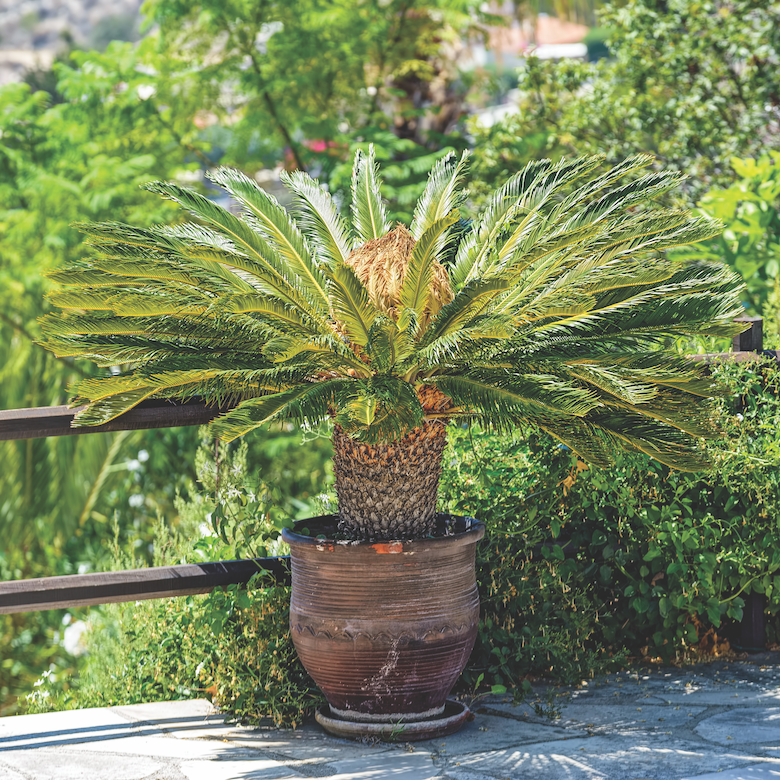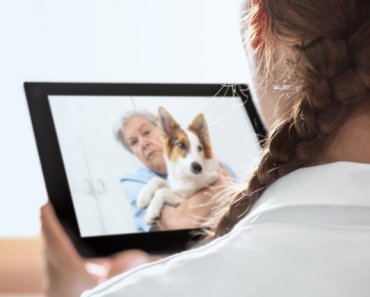In 2019, the ASPCA Poison Control Center reported that three of the most common pet toxins are those that can be found in the yard: garden products, pesticides and plants. Many dogs spend a great deal of time outside, and it is important that fences, gardens and outdoor buildings be properly dog-proofed to prevent accidental poisonings.
No grow zone

Sago palm. Photo: Kerri Rubio
Sago palms are a popular landscaping plant. They are beautiful and hardy but also extremely deadly to dogs. All parts of the plant are poisonous, but the seeds are the most lethal. Sago palms cause liver failure. Symptoms include vomiting, diarrhea, weakness, staggering, a yellow tint to the skin and clotting disorders. If you suspect that your dog has ingested any part of a sago, immediately contact your veterinarian. Do not delay to see if symptoms develop.
Mushrooms can cause significant illness. Effects range from mild gastrointestinal disease (vomiting, diarrhea, loss of appetite) to hallucinatory effects, tremors, seizures and liver failure. The symptoms depend on the type of mushroom ingested, and any suspected ingestion should warrant a trip to the veterinarian.
Additives = bad-atives
Fertilizers are frequent offenders. The good news is that most are relatively nontoxic. In some cases, a transient muscle stiffness and discomfort may be noticed. This tends to be short-lived and self-resolving.
Cocoa mulch used in garden beds can lead to symptoms of chocolate toxicity. This is because the hulls contain caffeine and theobromine, just like chocolate. Symptoms include vomiting, diarrhea, hyperactivity, tremors, cardiac arrhythmias and seizures.
Snail and slug baits are also frequently used to repel garden pests. These can cause severe tremors and death, as many contain metaldehydes. Make sure that all baits are secured away from curious noses. When possible, avoid their use altogether and opt for more natural options like “slug traps” made with crushed eggshells or coffee.

Mushrooms can cause significant illness. Photo: gorspb | Getty Images
Access denied
Composting materials can be a surprising source of toxicity. It is not the specific compost material that is poisonous to dogs but the mold that grows on the compost. This mold produces mycotoxins. These cause generalized weakness, tremoring, seizures and, as a result, elevated body temperature. Treatment is generally supportive with hospitalization for fluids and muscle-relaxant medications. It is rarely fatal if treated quickly and aggressively.
Spent hops are a fairly new toxicity as home brewing gains popularity. For reasons that are poorly understood, when ingested, spent hops cause significant hyperthermia (elevated body temperature) that can rapidly progress to heatstroke. Most cases respond to supportive care such as cooling and IV fluids. When home brewing, place used hops in a secure garbage receptacle and not with compost that can be accessed by your dog.
Blue-green algae (cyanobacteria) received national attention last year when several dogs were exposed. The algae grow on stagnant water such as that in ponds, lakes, puddles and even water collected in the yard. It is fatal within minutes to hours, and treatment is rarely effective. Keep your dog away from any water with algal blooms. It is impossible to visually determine the type of algae on water, so it is critical to completely avoid it.
Hop out of here
In certain areas of the country, such as the South and the Southwest, as well as Hawaii, Bufo toads abound. They are large toads that are extremely toxic. Bufotoxins located in the skin glands cause drooling, cardiac arrhythmias and death when released. Emergency care is warranted if Bufo exposure is suspected, as it can very quickly be fatal.
Help is here
If you suspect that your dog has ingested a toxin from the yard, contact the ASPCA Animal Poison Control hotline (888-426-4435). For a small fee, they can research the potential toxin and what medical treatment is needed. You can always consult with your veterinarian as well. Treatment is usually focused on decontamination with induction of vomiting, administration of activated charcoal to prevent further absorption, and possibly monitoring of blood values depending on the toxin. As with most things, prevention is the best approach, so lock up the gardening supplies!
Featured photo: tomasztc | Getty Images
Read Next: Gardening With Dogs: Tips for Creating a Pet-Safe Garden


























